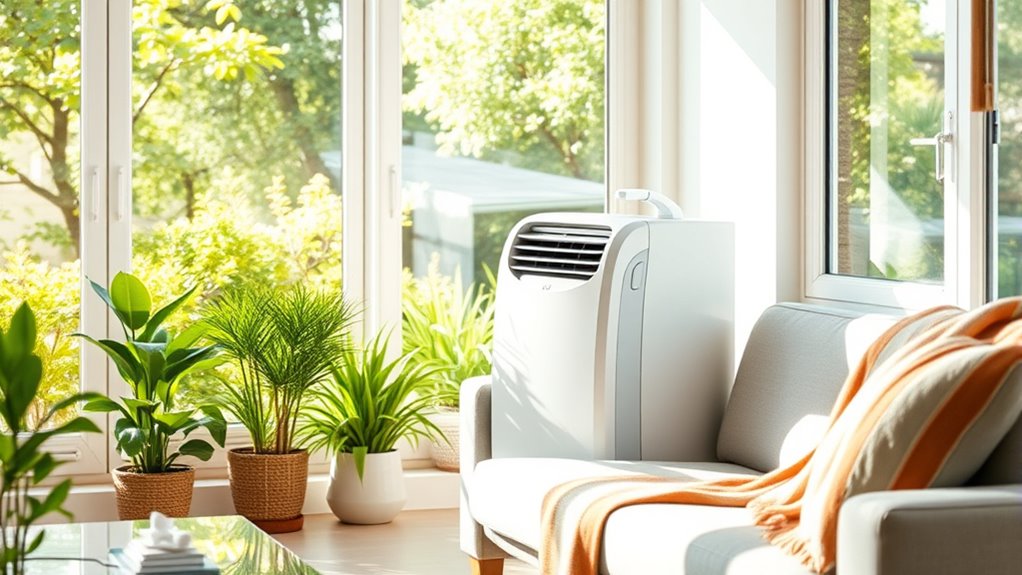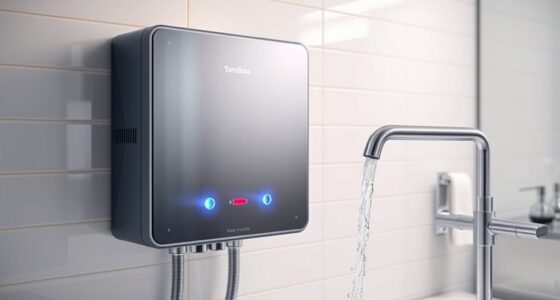Portable air conditioners offer a convenient way to cool your space without needing central air. They draw in warm, humid air, use refrigeration to chill it, and vent hot air outside through an adjustable hose. By choosing the right size and features, like dehumidification or Wi-Fi controls, you can enjoy effective cooling in various room sizes. Proper setup and maintenance ensure ideal performance. Keep exploring to learn how to get the most relief from your portable AC.
Key Takeaways
- Portable air conditioners cool individual rooms effectively without needing central HVAC systems.
- They use refrigeration cycles to remove heat and humidity, providing immediate relief in targeted spaces.
- Easy to install and vent through windows or walls, making them suitable for temporary or portable cooling.
- Various models offer features like timers, remote controls, and Wi-Fi for convenient operation.
- Proper sizing and venting ensure optimal performance, making portable ACs a flexible alternative to central air.
How Portable Air Conditioners Work to Cool Your Space
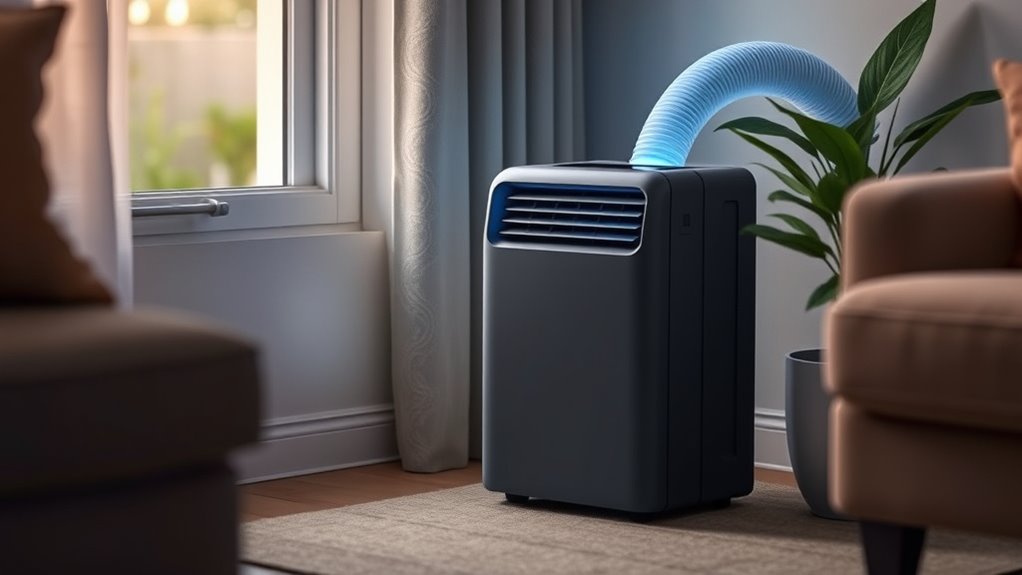
Portable air conditioners cool your space by drawing in warm, humid indoor air, then using a refrigeration cycle to lower its temperature. Inside, the compressor, condenser, and evaporator work together to remove heat and moisture from the air. The cooled air is then released back into the room, providing relief. To maintain efficiency, a vent hose connects the unit to an exhaust opening in a window or wall, directing the heat and moisture outside. Proper venting is essential because it prevents heat from recirculating into the room, which can reduce the cooling efficiency. Some models feature self-evaporative technology, recycling moisture to minimize drainage needs. Additionally, ensuring the use of effective air filtration helps improve indoor air quality during use. Proper placement and venting techniques are crucial for optimal performance. Overall, the effectiveness of your portable air conditioner depends on correct venting and room conditions, and understanding refrigeration cycles can help optimize performance.
Choosing the Right Size for Your Room
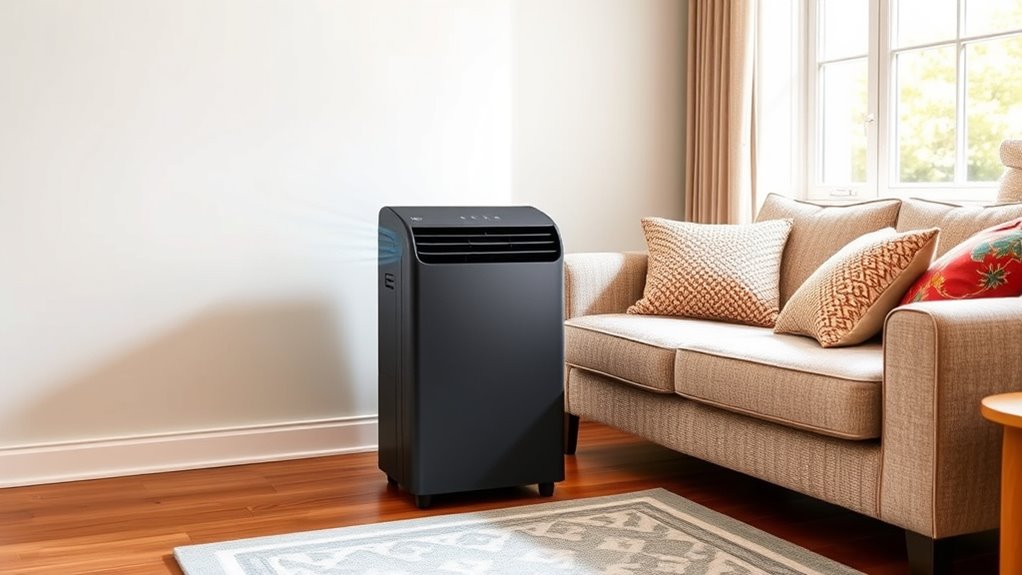
To get the most effective cooling, you need to match your portable air conditioner’s size to your room. Consider the coverage area to guarantee the unit can handle your space, whether it’s a small office or a large living room. Also, think about venting requirements to keep installation simple and efficient. For optimal results, selecting a unit that matches the best beaches and outdoor environment of your location can enhance comfort and enjoyment. Additionally, choosing a unit with the appropriate cooling capacity ensures energy efficiency and effective temperature control throughout your space. Understanding home security systems and their features can help you safeguard your space while enjoying cool relief. Incorporating sensor-activated controls can further optimize your cooling experience and energy use. Properly maintaining your unit by following air purifier maintenance dos and don’ts can also extend its lifespan and performance.
Room Size Compatibility
Choosing the right size air conditioner is essential for effective cooling and energy efficiency. Your portable AC’s cooling capacity, measured in BTU, should match your room size to prevent inadequate cooling or wasted energy. For smaller spaces around 100 sq. ft., units with about 5,000 BTU work well. Medium rooms, approximately 200 sq. ft., need models like 8,000 BTU. Larger areas, such as 450 sq. ft., require units like 10,000 BTU. Here’s a quick guide:
| Room Size (sq. ft.) | Recommended BTU | Coverage Area (approx.) |
|---|---|---|
| Up to 100 | 5,000 | Small rooms |
| 100-200 | 6,000-8,000 | Medium rooms |
| 200-450 | 8,000-10,000 | Larger rooms |
| Over 450 | 12,000+ | Spacious areas |
Matching your room size to the right cooling capacity ensures ideal comfort.
Coverage Area Range
Matching your air conditioner’s size to your room’s coverage area guarantees effective cooling and energy efficiency. Portable ACs come in a range of BTUs, designed to cool spaces from 45 sq. ft. to over 1200 sq. ft., aligning with specific room sizes. For small areas like closets or offices, models with around 8,000 BTU and 100 sq. ft. coverage work well. Larger rooms, such as living rooms, need units with 14,000 BTU for 700 sq. ft. or more. Many portable ACs clearly specify their coverage area, helping you choose the right size. When selecting, consider your room size and factors like insulation and sunlight, ensuring your portable AC provides ideal cooling without wasting energy. Proper sizing is key for comfort and efficiency. Using the correct size also helps prevent energy waste and enhances the unit’s performance. Additionally, understanding airflow dynamics can improve overall cooling effectiveness. Incorporating geothermal heat pump principles, such as maintaining proper airflow and system efficiency, can further optimize your cooling setup. Moreover, selecting a unit with adjustable fan speeds can help fine-tune cooling based on your room’s specific needs. Being aware of climate considerations can also influence your choice, ensuring optimal operation year-round.
Venting Requirements
Proper venting is essential for your portable air conditioner to work efficiently, as it removes the hot air generated during cooling. You’ll need a vent hose that matches your unit’s specifications, usually between 5 to 8 inches in diameter, to ensure proper airflow. Using an exhaust window kit, you can connect the vent hose securely to a window opening, which typically ranges from 20 to 50 inches wide depending on the model. It’s important to follow the venting requirements for your unit to prevent reduced performance, higher energy use, or exhaust leaks. Make sure to create an airtight seal around the vent hose and window kit, which helps maintain pressure, improve cooling efficiency, and stop warm air or humidity from re-entering the room. Proper venting also contributes to energy efficiency, ensuring your portable AC operates optimally with less power consumption. Additionally, selecting the right venting accessories can enhance the setup process and overall performance. To maximize cooling capacity, consider the placement of your portable air conditioner and the length of the vent hose, as longer hoses can sometimes reduce efficiency if not properly installed. Using high-quality venting components can further ensure a secure and efficient setup.
Key Features to Consider in Portable AC Units
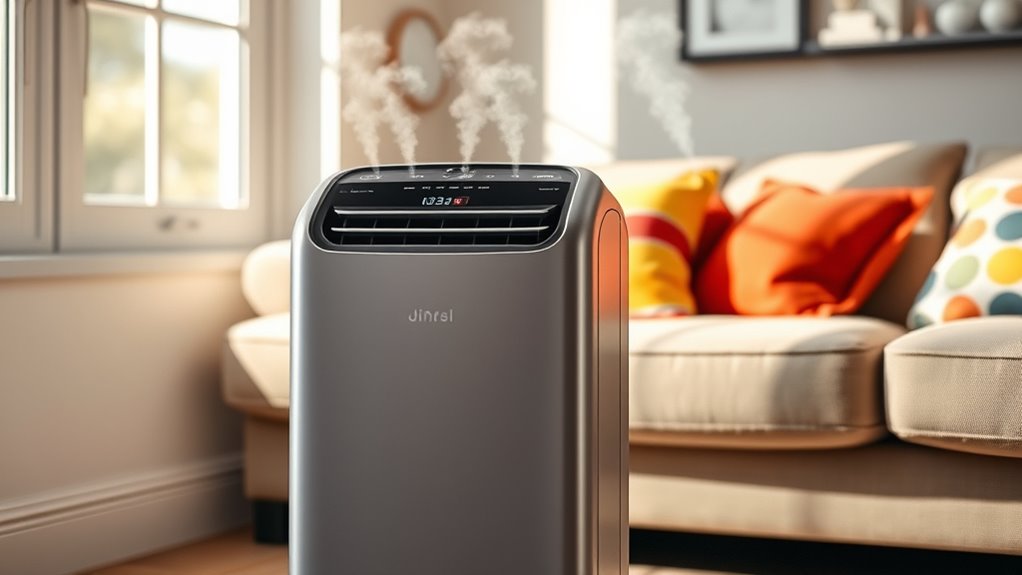
When choosing a portable AC, it’s important to contemplate features like coverage area to match your room size. Venting options and setup ease can impact installation and efficiency, while extra functions like dehumidifiers or Wi-Fi connectivity boost convenience. Focusing on these key points helps you select a unit that fits your needs perfectly.
Room Size Compatibility
Selecting a portable air conditioner that fits your space begins with understanding its room size compatibility. To guarantee effective cooling, choose a unit designed for your coverage area. The BTU rating indicates the cooling capacity needed for your room size; higher BTUs suit larger spaces. Many portable ACs specify their ideal room size, such as 200 sq. ft. or 450 sq. ft., helping you match the unit to your needs. Keep in mind:
- Smaller models are rated for about 100 sq. ft.
- Larger units cover over 450 sq. ft.
- BTU requirements increase with room size
- Proper coverage area ensures maximum performance
Matching the right portable air conditioner to your room size prevents inefficiency and keeps your space comfortably cooled.
Venting Options & Setup
Venting options are a key factor to contemplate when choosing a portable air conditioner, as they directly influence installation flexibility and cooling performance. The venting setup typically involves an exhaust hose, which directs hot air outside. Some units feature a single exhaust hose, while others have a dual-hose design, offering enhanced efficiency and faster cooling by balancing air intake and exhaust. Proper installation of the venting system is essential; improper setup can reduce cooling capacity and increase energy consumption. Many models include adjustable vent hoses and multiple exhaust port options, making it easier to fit different window sizes and room configurations. Your choice of venting system impacts not only ease of installation but also the overall effectiveness of your portable AC unit. Additionally, understanding sound healing science can help you select units with quieter operation, ensuring a peaceful environment. When selecting a portable AC, consider installation requirements to ensure the setup aligns with your space and minimizes potential issues.
Extra Features & Functions
Portable air conditioners come equipped with a variety of extra features and functions that can substantially enhance your comfort and convenience. These features allow you to customize your cooling experience and simplify operation. With a remote control, you can adjust settings from across the room without getting up. Programmable timers let you schedule when the unit turns on or off, saving energy. Multiple modes, like fan, dehumidify, sleep, and automatic, help tailor the airflow and air quality to your needs. For added convenience, some models offer smart-home compatibility, enabling voice control through Amazon Alexa or Google Assistant. Additional functionalities include built-in dehumidifiers, ionizers, and energy-efficient modes, making your portable AC more versatile and user-friendly.
Top-Rated Portable Air Conditioners for Every Need
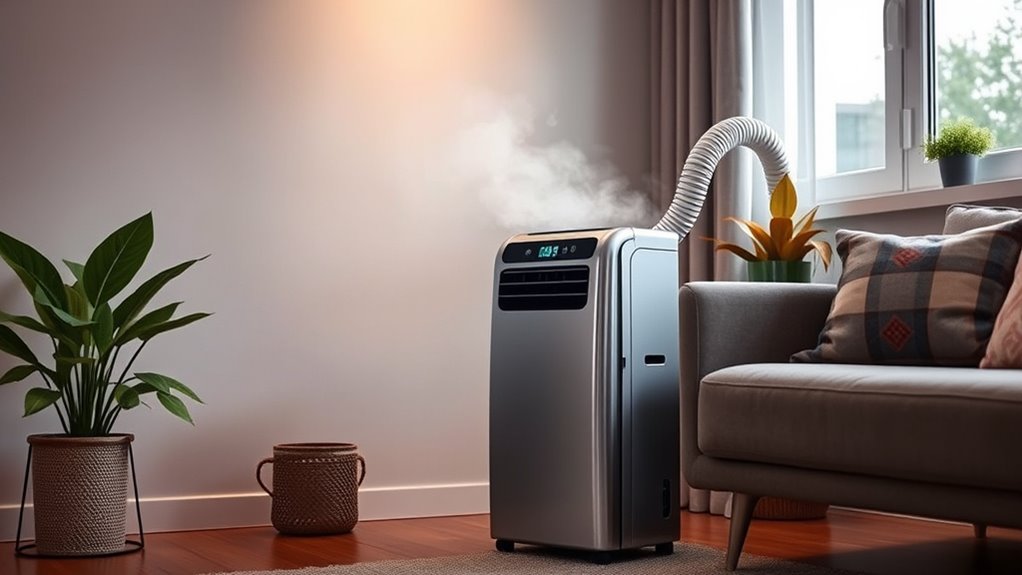
No matter the size of your space, there’s a top-rated portable air conditioner that fits your needs. Whether you need a compact unit to cool a 45 sq. ft. room or a powerful conditioner that covers over 1200 sq. ft., options are stocked and ready. Leading brands like Toshiba, Vissani, Westinghouse, Whynter, and Frigidaire offer models with advanced features such as Wi-Fi connectivity, inverter technology, and even heat functions. Many high-rated units include self-evaporative systems, which recycle or expel moisture, reducing maintenance. These popular models often come with remote controls, programmable timers, and multi-mode operation for maximum convenience. With in-stock options available at major retailers, you can enjoy same-day, next-day, or free delivery, making it easy to find the perfect portable conditioner for your needs.
Benefits of Self-Evaporative Technology in Portable ACs
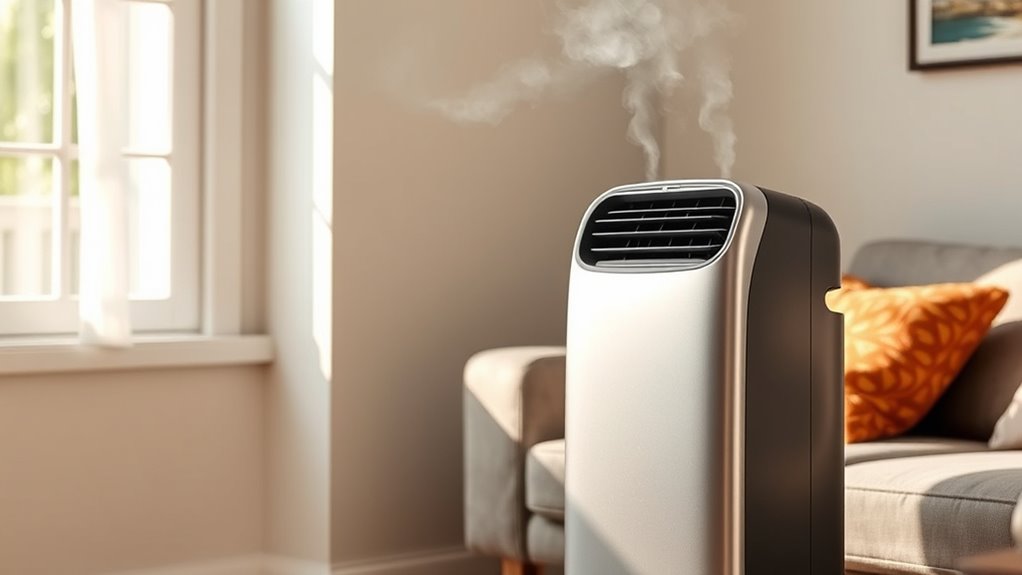
Self-evaporative technology offers significant advantages by recycling residual moisture, which reduces or even eliminates the need for manual drainage. This system expels moisture through the exhaust hose as vapor, often surpassing the humidity it generates—especially in lower humidity environments. Dual-hose models boost evaporation efficiency, allowing more moisture to be expelled, which improves cooling performance and keeps internal humidity in check. Even in high humidity or dehumidify mode, some moisture may collect internally and need draining, but overall, self-evaporative systems simplify operation.
- Reduce maintenance needs
- Improve cooling performance
- Minimize manual drainage
- Enhance user convenience
Tips for Easy Setup and Maintenance
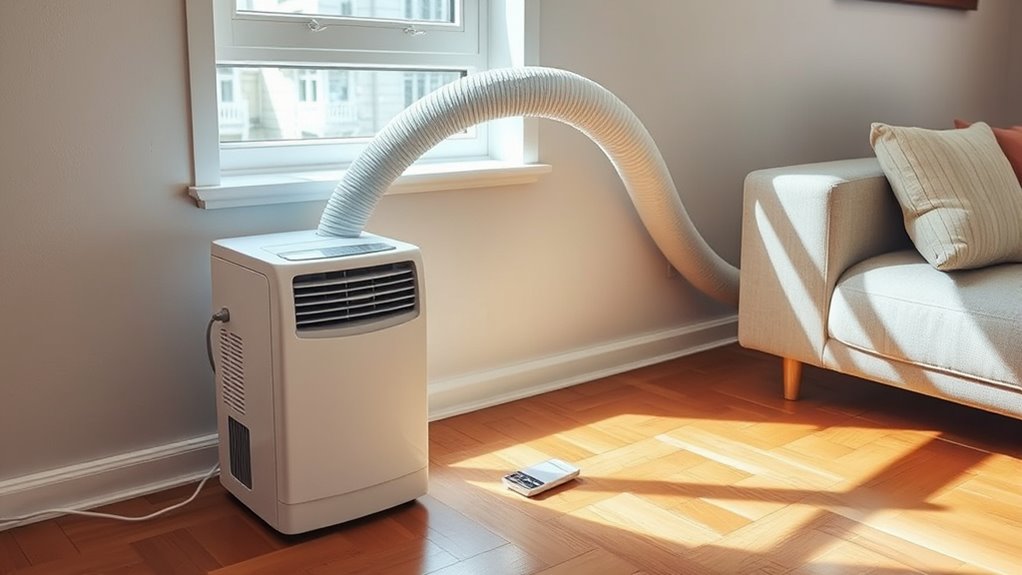
To guarantee your portable air conditioner operates efficiently, proper setup and regular maintenance are essential. Start by placing it on a flat, level surface near a window to ensure effective venting. Use the included window kit to secure the exhaust hose properly, and check that the hose isn’t kinked or blocked to maintain airflow and cooling. Keep the air filters clean by inspecting and replacing them every 2-3 months to prevent dust buildup and keep the unit running smoothly. In high humidity, regularly drain any accumulated moisture from the reservoir to sustain consistent cooling. Additionally, use the remote control or timer features to schedule operation, reducing energy use. Proper setup and routine maintenance will keep your portable AC functioning at its best.
Comparing Costs and Energy Efficiency
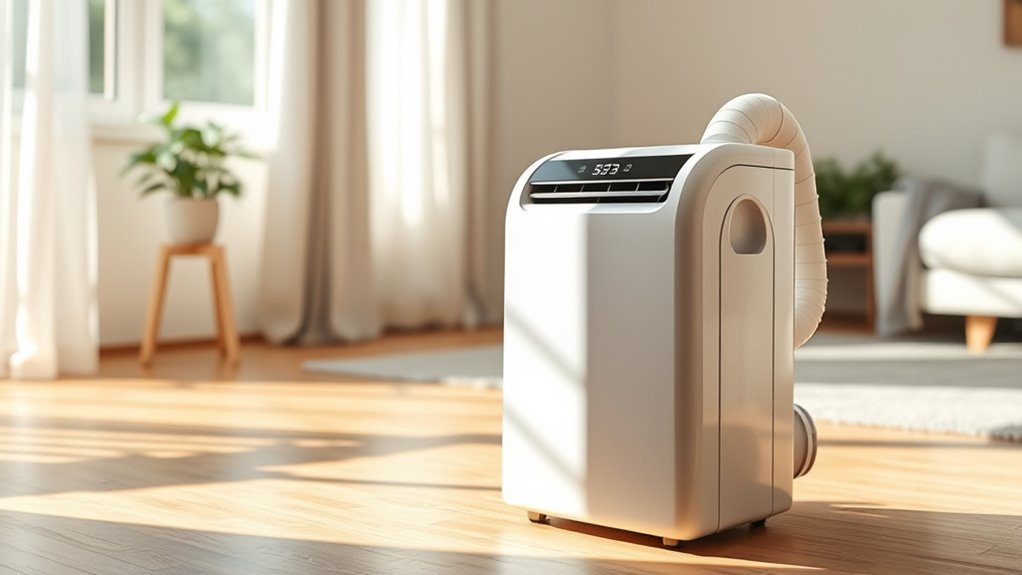
When selecting a portable air conditioner, understanding the differences in costs and energy efficiency can help you make a smarter choice. Higher energy efficiency, measured by SEER ratings, can lower your monthly operating costs—sometimes by up to 30%. Models with better BTU capacity match room size more effectively, improving efficiency and comfort. Keep in mind, premium units with advanced smart features like programmable timers and Wi-Fi often cost more upfront but save money in the long run through optimized energy use.
Here’s what to contemplate:
- Higher SEER ratings = better energy efficiency
- Lower operating costs with efficient models
- BTU capacity tailored to your room size
- Smart features to enhance energy management
Enhancing Comfort With Portable AC ACcessories
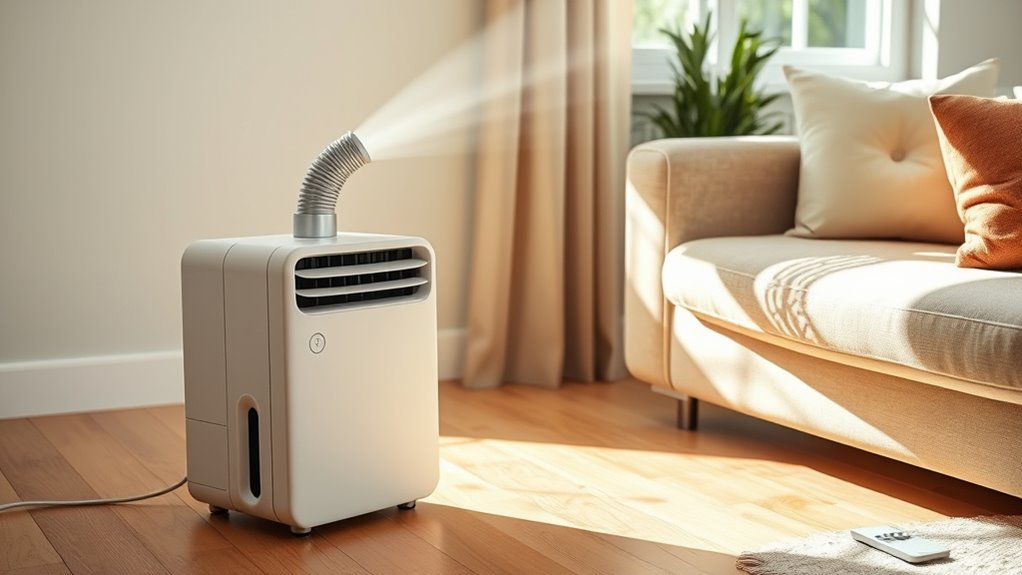
Enhancing comfort with portable AC accessories is key to maximizing your unit’s performance and ensuring efficient cooling. A high-quality vent hose improves airflow and cooling, especially if your unit has multiple vent options. Properly attaching the exhaust adapter guarantees that hot air is expelled effectively, boosting efficiency. Using a well-fitted window kit helps create a secure seal, preventing air leaks that can undermine cooling efforts. Sealing air leaks around the window kit and hose connections keeps the cool air in and hot air out, maintaining a consistent room temperature. Additionally, accessories like adjustable vent hoses and custom-fit window panels can further optimize airflow and reduce energy consumption. Investing in these accessories makes your portable AC more effective and enhances your overall comfort.
Frequently Asked Questions
Do All Portable Air Conditioners Have to Be Vented Out a Window?
You might wonder if all portable air conditioners need venting through a window. The answer is yes, most do. Venting helps expel warm air and keeps the unit working efficiently. Without proper venting, your portable AC can’t cool effectively and may overheat. Some models have dual hoses or ventless options, but generally, you’ll need to vent through a window or door to get the best cooling performance.
Do Ductless Air Conditioners Really Work?
Yes, ductless air conditioners really work. You’ll find they’re highly effective at cooling specific rooms or zones, especially when properly installed and sized. These systems operate quietly and can be customized with features like inverter technology and multi-zone controls. You’ll notice improved comfort quickly, and since they don’t require ductwork, they’re a flexible and energy-efficient solution for cooling your space.
What Is the Difference Between an Air Cooler and a Portable Air Conditioner?
You want to know the difference between an air cooler and a portable air conditioner. While an air cooler uses water evaporation to cool the air, providing moist, invigorating comfort mainly in dry climates, a portable AC actively removes heat and humidity, offering cooler, drier air. Portable units typically have higher capacity and precise temperature control, making them better suited for humid environments and larger spaces.
How Do Self-Evaporating Portable Air Conditioners Work?
Self-evaporating portable air conditioners work by recycling moisture inside the unit. They use internal technology to condense humidity and then automatically evaporate it through exhaust hoses, reducing the need for manual drainage. As you run the unit, it continuously removes moisture from the air, making it more efficient. In high humidity, you might still need to drain occasionally, but these models are designed to minimize that task.
Conclusion
While central air offers seamless cooling, portable air conditioners provide flexibility and convenience. They may lack the silent luxury of a built-in system, but their mobility lets you cool any room on demand. In essence, you trade permanence for adaptability, comfort for convenience. Whether you crave a quick respite or a long-term solution, portable ACs bridge the gap between necessity and comfort—an elegant compromise in a world of ever-changing needs.
